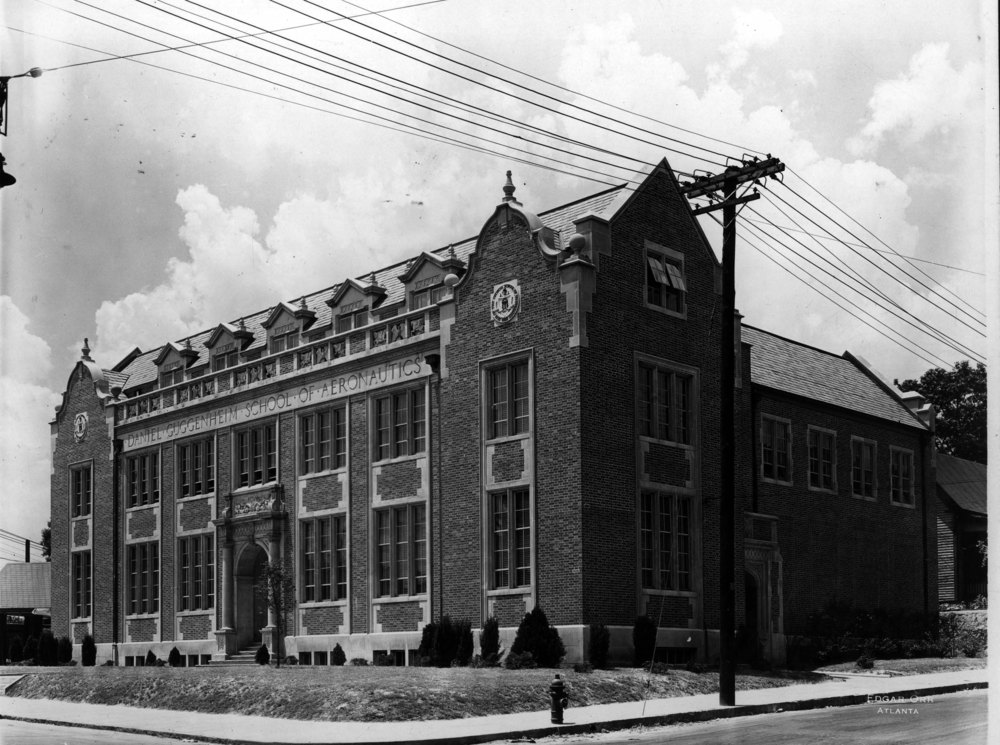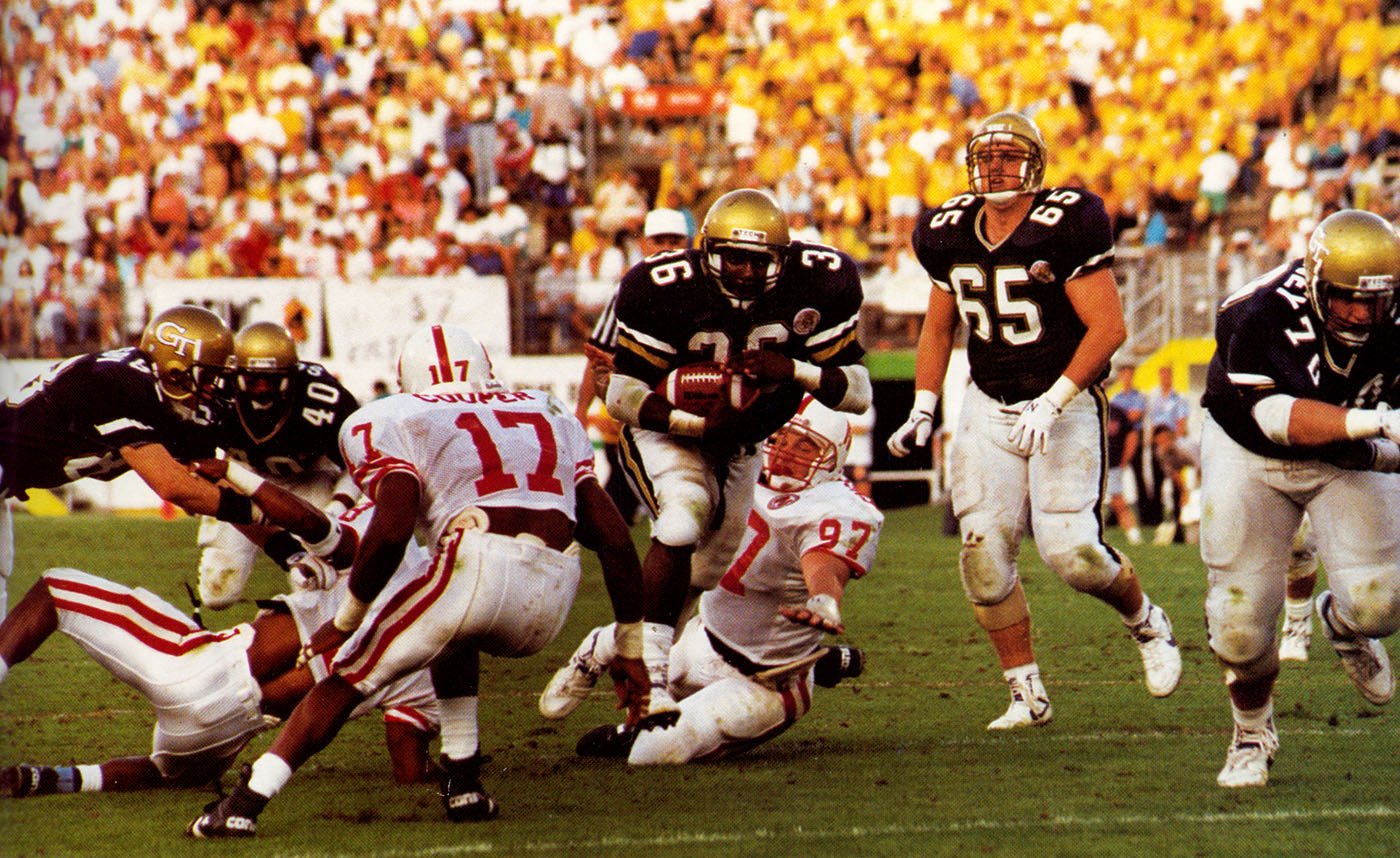The Astronauts of Georgia Tech
By: Jack Purdy, BA 22 | Categories: Tech History
Every decade since the beginning of human spaceflight in 1961, Georgia Tech graduates have been to space. As of 2025, there has been at least one Yellow Jacket on 40 separate spaceflight missions, totaling 595,164,815 collective miles flown in space by Tech astronauts.
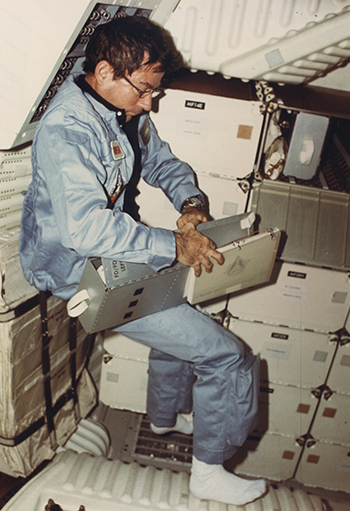 John Young, AE 52, HON PhD 03, became Tech’s first astronaut, flying on Gemini III in 1965. It was the first time two Americans flew together on a single mission. On Apollo 16 in 1972, Young became the first and (so far) only Yellow Jacket to land on the moon. Young and the crew collected over 200 pounds of lunar rocks from the moon’s surface and travelled over 16 miles on the lunar rover. A lunar sampled collected by Young is on display at Georgia Tech in the Price Gilbert Library. In Young’s earlier Apollo Apollo 10 mission in 1969, he orbited the moon to survey lunar landing spots for future missions.
John Young, AE 52, HON PhD 03, became Tech’s first astronaut, flying on Gemini III in 1965. It was the first time two Americans flew together on a single mission. On Apollo 16 in 1972, Young became the first and (so far) only Yellow Jacket to land on the moon. Young and the crew collected over 200 pounds of lunar rocks from the moon’s surface and travelled over 16 miles on the lunar rover. A lunar sampled collected by Young is on display at Georgia Tech in the Price Gilbert Library. In Young’s earlier Apollo Apollo 10 mission in 1969, he orbited the moon to survey lunar landing spots for future missions.
After the Apollo missions, Young commanded NASA’s first space shuttle mission, STS-1, in April 1981. Young’s final flight, STS-9, was the first time six people flew on a single vehicle into space and Young became the first person to perform six space flights (seven if you include launching off the moon).
Seven months after STS-1, Richard Truly, AE 59, HON PhD 09, flew on STS-2 aboard Columbia, making it the first shuttle to fly twice and carry two Georgia Tech astronauts. Truly’s second flight came on STS-8 in 1983, which was the first night launch and landing performed by NASA.
A Legacy of Excellence
From 1991 to 2021, Georgia Tech graduates flew on 25 more space shuttle flights and 11 International Space Station Expeditions. John Casper, Cls 65, spent his first year of college at Tech in 1961, before he enrolled in the Air Force Academy. Casper flew in four missions in the 1990s. Jan Davis, Bio 75, became Tech’s first female astronaut, flying on three shuttle missions that included materials science experiments and the first shuttle mission with a cosmonaut, a Russian astronaut.
Mission with the Most Yellow Jackets
Some missions have even included multiple Yellow Jackets, such as STS-126, where pilot Eric Boe, MS EE 97, and mission specialists Shane Kimbrough, MS OR 98, and Sandra Magnus, PhD CerE 96, traveled to the International Space Station. Upon arrival, Magnus stayed at the ISS as part of Expedition 18.
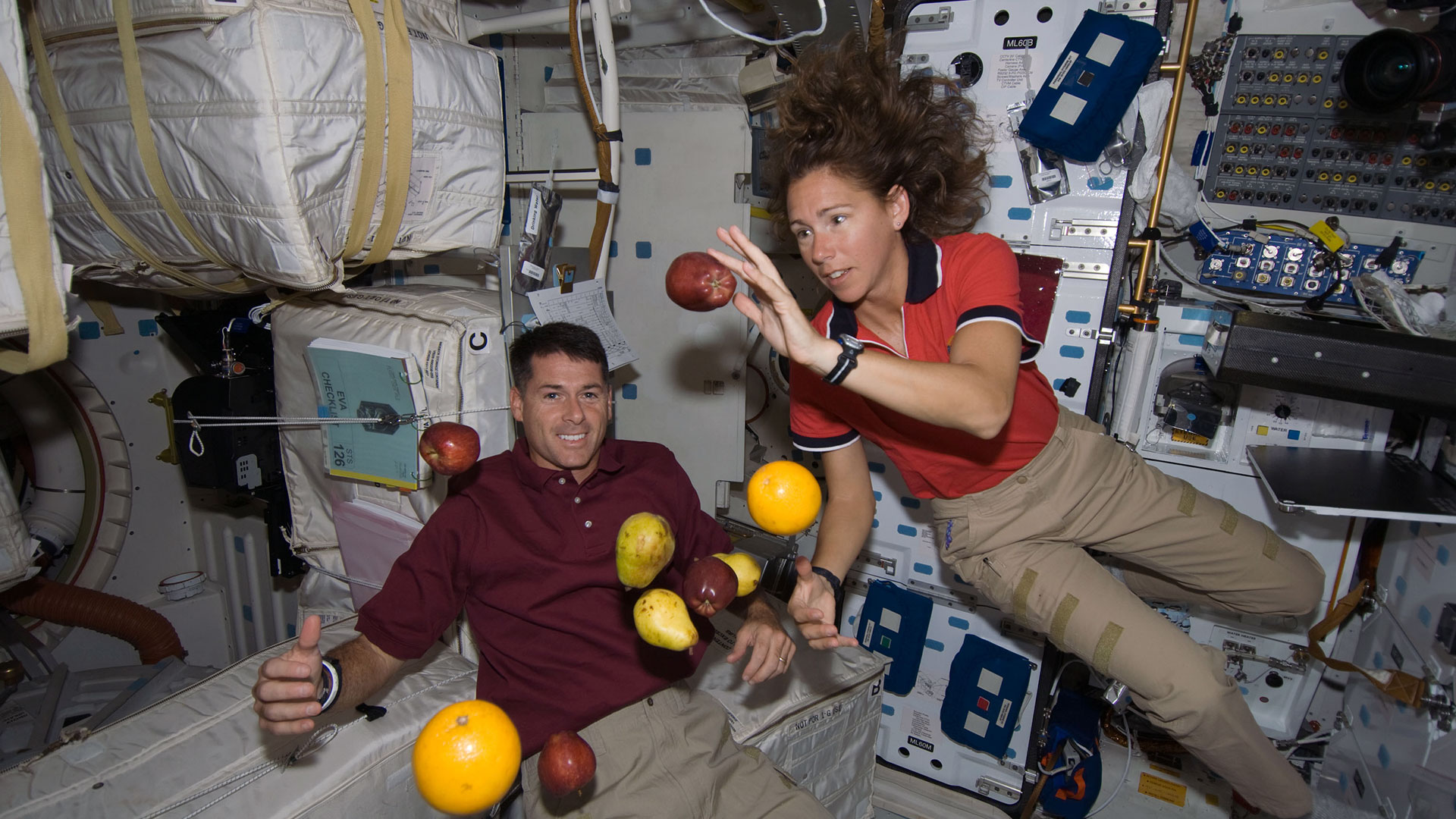 Kimbrough and Magnus together on the International Space Station. (Courtesy: NASA)
Kimbrough and Magnus together on the International Space Station. (Courtesy: NASA)
Boe’s second mission, STS-133, initially had Tim Kopra, MS AE 95, as a mission specialist, but Kopra was replaced after a bicycle accident. Kopra would later fly on Expedition 46/47.
Most Miles Earned by an Alumnus
Kimbrough has accumulated the most miles flown in space of any Yellow Jacket, traversing a whopping 170,615,109 miles over three missions. On his most recent mission, Expedition 65/66 in 2021, Kimbrough covered 84 million miles, the most in a single flight in space by a Yellow Jacket.
Both Douglas Wheelock, MS AE 92, and Kimbrough have served as commanders of the International Space Station. Wheelock served as commander during Expedition 25 in 2010, which involved him going on multiple unplanned spacewalks to repair the station. Kimbrough’s command came during Expedition 50 from 2016 to 2017, where he orbited the earth 2,770 times and performed four spacewalks.
Georgia Tech’s Astronauts
John Young (AE ’52, HON PhD ’03); Richard “Dick” Truly (AE ’59, HON PhD ’09); John Casper (Cls ’65); Blaine Hammond, Jr. (MS ESM ’74); Jan Davis (Bio ’75); Scott “Doc” Horowitz (MS AE ’79, PhD AE ’82); Rich Clifford (MS AE ’82); Bill McArthur (MS AE ’83); Susan Kilrain (MS AE ’85); Alan “Dex” Poindexter (AE ’86); Doug Wheelock (MS AE ’92); Tim Kopra (MS AE ’95); Sandra Magnus (PhD CerE ’96); Eric Boe (MS EE ’97); Shane Kimbrough (MS OR ’98).
Space Wrecks
Fourteen vehicles have been used to fly Tech astronauts into space. Four are of Russian origin, nine are NASA vehicles, and one from SpaceX. All five of the orbiters from the Space Shuttle Program were flown by a Jacket, plus three Apollo modules, and the Orion Lunar Rover by Young on the moon. During Young’s Gemini missions, the Titan II rocket was used both times.
NASA Vehicles: Apollo 16 Command & Service Module + Orion Lunar Module + lunar rover; Apollo 10 Command & Service Module. Gemini III Capsule; Gemini X Capsule. NASA Space Shuttles: Columbia (STS-1, -2, -9, -58, -75, -83, -94); Challenger (STS-8); Atlantis (STS-74, -76, -101, -112, -122, -135); Discovery (STS-39, -53, -60, -64, -82, -85, -92, -105, -120, -131, -133); Endeavour (STS-47, -59, -126, -127).
Russian missions: Soyuz 11 (Expedition 12); Soyuz TMA-19 (Expedition 24); Soyuz TMA-19M (Expedition 46); Soyuz MS-02 (Expeditions 49 & 50).
Space X: Dragon Endeavour (Expedition 65).
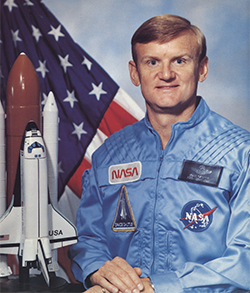 John Casper
John Casper
John Casper, Cls 65, spent his first year of college at Georgia Tech in 1961-1962, joining the freshman football team and dressing out for one game against Clemson. In fall 1962, he enrolled at the Air Force Academy to complete his undergraduate then Purdue University for his graduate degree. Casper flew in four missions (STS-36, STS-54, STS-62, STS-77) in the 1990s. If you include those missions, Tech’s total mileage flown jumps to 609,466,092 miles. Casper was the commander for the last three of his missions and held multiple positions within NASA throughout the 2000s.
Georgia Tech’s Flag and Souvenirs Fly in Space
Yellow Jacket astronauts have a long history of bringing a bit of Tech with them to the cosmos.
When Georgia Tech astronauts head to space, it’s been commonplace for them to bring a piece of campus for the ride. NASA space flights include kits for astronauts and organizations to bring items to space such as flags, pennants, and medallions.
Uniforms and the Fastest Fastball
Football Jerseys: On his first mission to space, STS-2, Richard “Dick” Truly, AE 59, HON PhD 09, brought two Georgia Tech football jerseys aboard space shuttle Columbia. After returning to Earth, Truly presented one of the jerseys to then-Tech President Joseph Pettit before a basketball game at Alexander Memorial Coliseum (now McCamish Pavilion), gifting one of the first pieces of Georgia Tech memorabilia to have left Earth and returned back to the Institute. 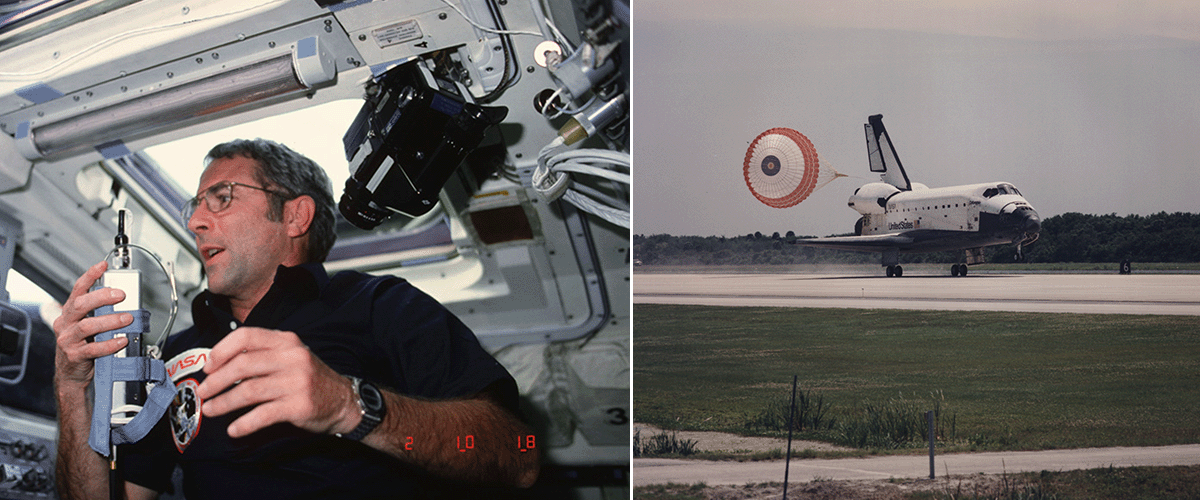 Truly working aboard Columbia during STS-2 (Left). Space Shuttle Columbia landing with astronaut Richard "Dick" Truly, AE 59, HON PhD 09, aboard (Right).
Truly working aboard Columbia during STS-2 (Left). Space Shuttle Columbia landing with astronaut Richard "Dick" Truly, AE 59, HON PhD 09, aboard (Right).
Fight Song: On August 31, 1983, during Truly’s second mission, ground control played the Georgia Tech fight song to wake up the crew on Challenger, part of a long history of collegiate fight songs being played to start the day for NASA astronauts in space.
Baseball Gear and First Pitch: Not only did Shane Kimbrough, MS OR 98, bring a Tech baseball jersey, baseball and hat during Expedition 55, he became the fourth astronaut (and first Yellow Jacket) to throw a ceremonial first pitch from space. He was the first astronaut to do so for a college baseball game. Aboard the International Space Station, he threw the pitch at an impressive 17,500 miles per hour for Georgia Tech’s May 21, 2021 game against North Carolina. The Jackets won 10-9.
Watch Shane Kimbrough throw a pitch inside the ISS  Kimbrough's Georgia Tech Baseball jersey, baseball, and hat inside International Space Station. Photos courtesy Shane Kimbrough
Kimbrough's Georgia Tech Baseball jersey, baseball, and hat inside International Space Station. Photos courtesy Shane Kimbrough
Georgia Tech Flag and Shirt: On Expedition 12 at the International Space Station, Bill McArthur, MS AE 83, virtually ran the Houston Half Marathon strapped to a treadmill and wearing a Georgia Tech T-shirt. He also brought a Georgia Tech flag that was placed on the shuttle hatch. 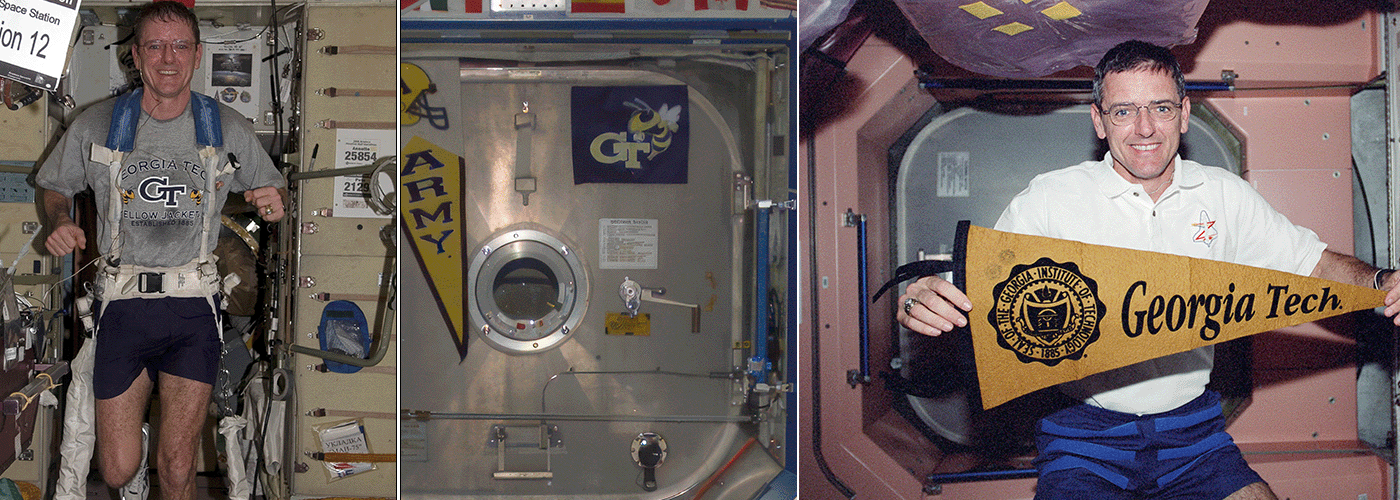 McArthur on the International Space Station treadmill, the Georgia Tech flag that lived on the shuttle hatch, and McArthur during STS-92 during which he performed two spacewalks. Photos courtesy Bill McArthur
McArthur on the International Space Station treadmill, the Georgia Tech flag that lived on the shuttle hatch, and McArthur during STS-92 during which he performed two spacewalks. Photos courtesy Bill McArthur
During STS-92 aboard Discovery, McArthur flew with a 1990s-era Georgia Tech pennant.
On STS-36, John Capser, Cls 65, also had a flag aboard Atlantis. 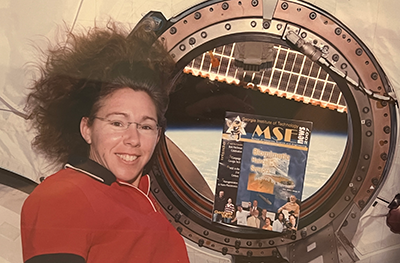 Georgia Tech Reading Material: In the Love Manufacturing Building, a photo of Sandra “Sandy” Magnus, PhD CerE 96, (pictured right) is displayed of her floating next to a 2007 School of Materials Science and Engineering news magazine during Expedition 18.
Georgia Tech Reading Material: In the Love Manufacturing Building, a photo of Sandra “Sandy” Magnus, PhD CerE 96, (pictured right) is displayed of her floating next to a 2007 School of Materials Science and Engineering news magazine during Expedition 18.
Georgia Tech pennant: Scott “Doc” Horowitz, MS AE 79, PhD AE 82, brought up the same Georgia Tech pennant during his four missions, plus a photo of his wife and child in front of Tech Tower.
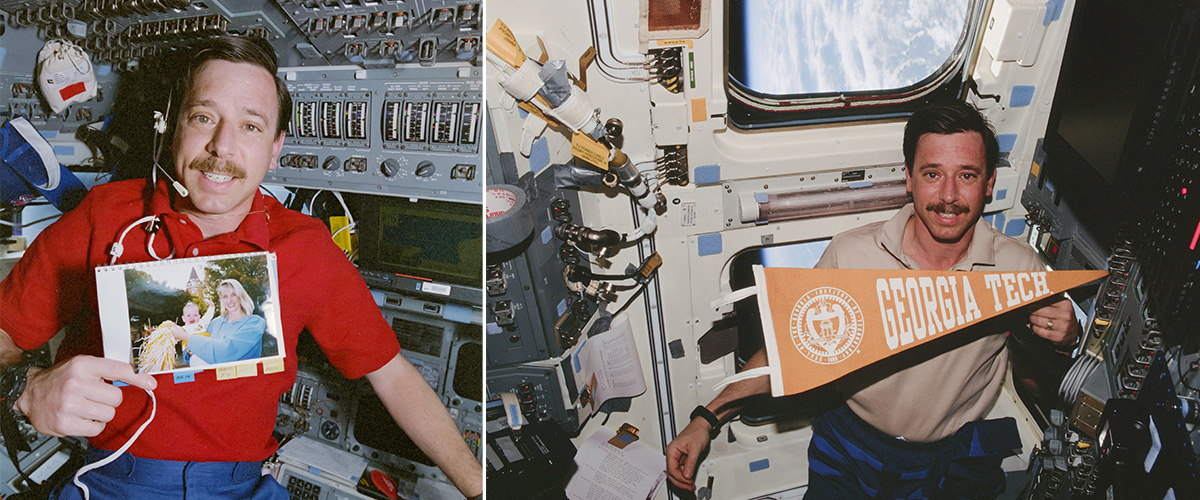 Horowitz STS-75 Caption: STS-75, Horowitz’s wife and daughter in front of Tech Tower
Horowitz STS-75 Caption: STS-75, Horowitz’s wife and daughter in front of Tech Tower
Similarly, on STS-60, Jan Davis, Bio 75, had her own Georgia Tech pennant in space. 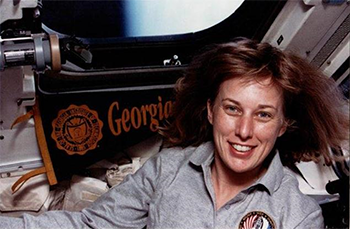
Burdell in Space: Georgia Tech astronauts aren’t the only Yellow Jackets to bring a piece of Tech to space. In the summer of 2019, the PROX-1 satellite built by Georgia Tech Professor E. Glenn Lightsey’s team flew aboard the SpaceX Falcon Heavy rocket and included George P. Burdell’s name engraved on the side. The Burdell-inscribed satellite continues to circuit the globe today and its location can be tracked live.
Tech’s Longstanding Connection with NASA
Over 95 years, Tech’s aerospace program has been a key figure in flight technology
Georgia Tech’s link to NASA dates back to the space agency’s creation in 1958. Ever since President Dwight Eisenhower signed the National Aeronautics and Space Act into law, Tech’s Daniel Guggenheim School of Aerospace Engineering has served as a launching pad for prospective astronauts (14 Tech graduates have become astronauts) and aerospace engineers working at NASA.
Within three years of its existence, NASA sent the first American to space. Just four years later in 1965, NASA sent the first Yellow Jacket, John Young, AE 52, HON PhD 03, into space.
Even before NASA was created, Tech’s Guggenheim students were contributing to flight technology that would eventually lead to space flight technology, including early advancements in the development of metal planes and jet engines after World War I.
“They had just moved into aircraft that were metal. So just right after World War I, they’re ramping up through metal aircraft. They’re doing large piston driven aircraft. They’re getting ready for jet engines, which are going to come online in the late ’40s, early ’50s,” says Mitchell Walker, professor and William R.T. Oakes Jr. School Chair of the Daniel Guggenheim School of Aerospace Engineering.
Tech students at the same time were contributing to the development of helicopters. “They were doing all the propeller theory and blade theory, they’re doing all the structural analysis,” says Walker.
Tech’s close research partnership with NASA has continued throughout the decades.
In 1984, after handwriting his proposal for a NASA program manager, Paul Steffes, Professor Emeritus in the School of Electrical and Computer Engineering, began planetary atmosphere research studying microwave properties for the Venus and Other Planets Exploration Projects. His grant from NASA lasted 32 years through 2016. That research extended to the Magellan mission, where he designed an experiment to study Venus’ atmosphere using microwave signals.
In 1985, Tom Elfe, Phys 48, led work in the Energy and Materials Science Laboratory on developing the solar dynamic power system to generate power for what was then the NASA Space Station, before it became known as the International Space Station.
In 2015, Tech partnered with the Jet Propulsion Laboratory (JPL), which has fostered multiple initiatives, including the Lunar Flashlight mission in 2021 that sought to find ice on the surface of the Moon. When NASA turned over control of the Lunar Flashlight spacecraft to Georgia Tech in 2023, Tech became the first higher ed institution to own and operate an interplanetary spacecraft.
In addition to research, Georgia Tech has provided NASA with talented graduates who have served at all levels of the agency.
Of Tech’s 14 astronauts, 11 completed flight school and became test pilots before being selected as NASA astronauts.
Some have returned to Tech after NASA, including Richard Truly, AE 59, PhD HON 09, who after serving as NASA’s eighth administrator starting in 1989, became the director of the Georgia Tech Research Institute from 1992 to 1997. Sandra “Sandy” Magnus, PhD CerE 96, who among her NASA roles flew on three space missions, is currently a Professor of the Practice in the Daniel Guggenheim School of Aerospace Engineering. Robyn Gatens, ChE 85, has served as the director of the International Space Station since 2021 and directs NASA’s Commercial Spaceflight Division.
“When you look at the big aerospace schools, NASA looks directly to them for its new graduates,” says Walker. “Our proximity to NASA Marshall has helped a lot. Our proximity to Johnson has helped a lot. Students know they can come here, and there is a very, very high likelihood if they want to work in NASA, we will make that happen for them.”
Do you have any stories or memories about Georgia Tech and Yellow Jackets in Space? Share them here!
